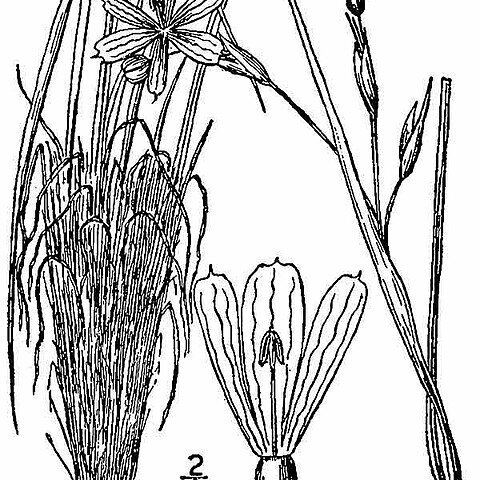Herbs, perennial, cespitose, yellowish green to olive green when dry, to 5.3 dm, not glaucous. Stems branched, with 1 node, 1–1.7 mm wide, glabrous, margins entire, similar in color and texture to stem body; internode (20–)23–47 cm, longer than leaves, with 1–5 branches. Leaf blades glabrous, bases becoming fibrous, persistent in tufts. Inflorescences borne singly; spathes green, obviously wider than supporting branch, glabrous, keels entire; outer 12–18 mm, 0.9 mm shorter to 1.7 mm longer than inner, tapering evenly towards apex, margins basally connate 2.1–4 mm; inner with keel straight, hyaline margins 0.2–0.4 mm wide, apex acute to obtuse, ending at or to 0.5 mm proximal to green apex. Flowers: tepals blue to bluish violet, bases yellow; outer tepals 7.9–11.6 mm, apex emarginate, aristate; filaments connate ± entirely, stipitate-glandular basally; ovary similar in color to foliage. Capsules light to medium brown, ± globose, 2.9–4.3 mm; pedicel erect to ascending. Seeds globose to obconic, lacking obvious depression, 1–1.5 mm, rugulose. 2n = 32.
More
Light green, but blackening in drying, ± erect, 1–5 dm; old lf-bases persistent as prominent tufts of light brown, fragile fibers often several cm long; stem only narrowly winged, minutely denticulate along the margins, usually not geniculate at the nodes; lvs 1–3.5 mm wide, spathes evidently peduncled from the axils of lf-like bracts, generally not geniculate; outer bract of the spathe mostly 1.5–2 cm, its margins connate for 2.5–4 mm at base; inner bract not much shorter than the outer; tep 5–8 mm, violet; fr 3–5 mm; 2n=32. Sandy areas, mainly near the coast, from Mass. to Fla. and Miss., andirregularly inland to Mich. and Mo. (S. arenicola; S. farwellii)

